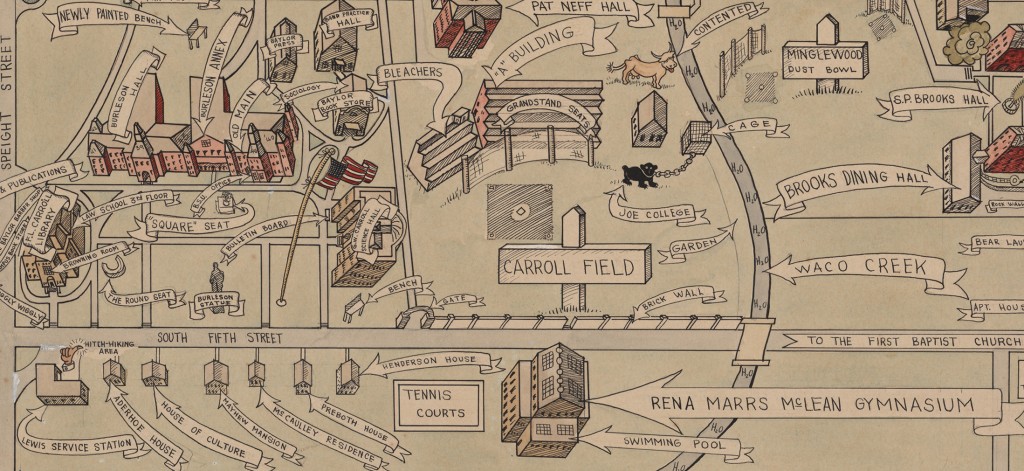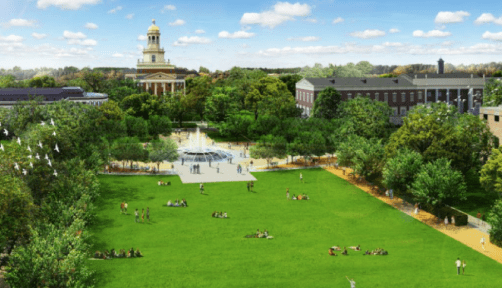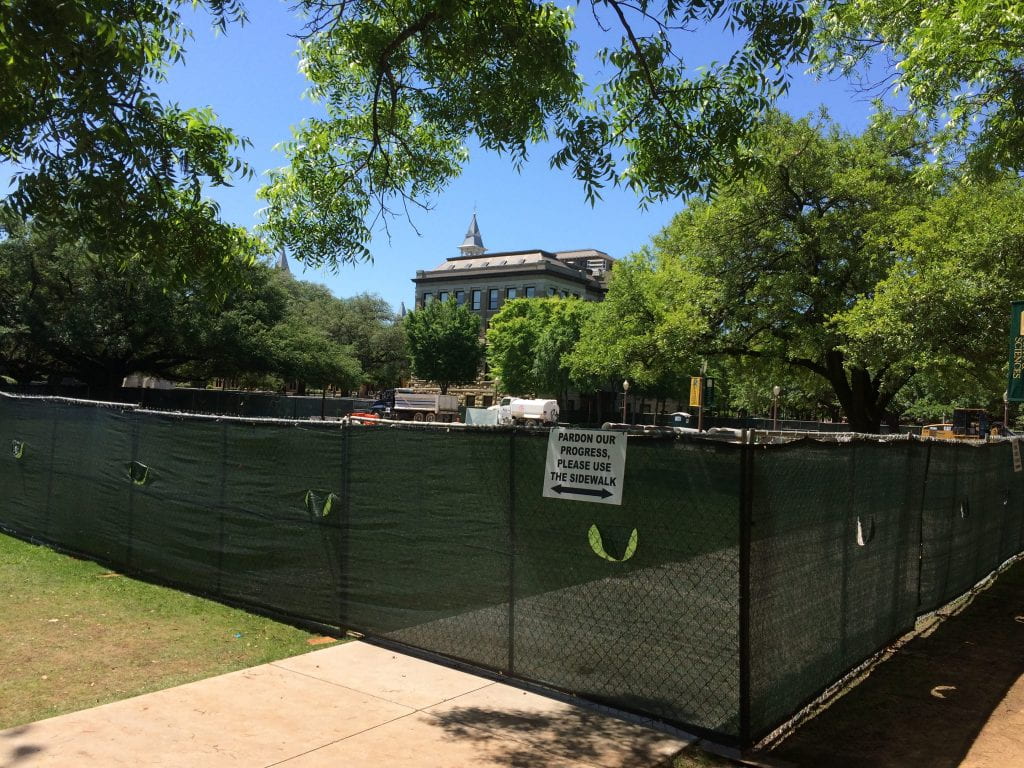To the Baylor Campus Community,
As President Abraham Lincoln said during the dark days prior to the outbreak of the American Civil War, “A house divided against itself cannot stand.” Those words may have slipped into the realm of cliche to those of us in the enlightened 21st century, but they hold truer than ever as we face the great struggle of our time: the Bearlin Wall.
Battle lines have been drawn. Entrenchments have been entrenched, forts have been fortified, provisions have been provided for: conflict is imminent. Passions are inflamed as loyalties are pledged to the King in the North (Art Briles) and the King in the South (Burt Burleson and/or Ken Starr – there appears to be a power struggle afoot).
But may we, your humble digital collections social media team, ask you all to cool your ardor for confrontation and consider that this divisive situation actually has historic precedent, as made evident by this surviving artifact of what became known as the 5th Street War of 1939*.
And this conflict featured a brick wall.
This hand drawn map, created by E.H. Ramirez, documents a time of division and turmoil that coincided with the general political unease felt around the world in the run-up to World War II. Here is the map in its entirety:

1939 map of campus by E.H. Ramirez
As you can see, the majority of campus development at the time was in the more industrialized, heavily settled South. The dividing line then, as now, was Fifth Street. While the North was largely rural at the time of the 5th Street War, it did house the Rena Marrs McLean Gymnasium, which meant the Northern forces had access to a swimming pool, so they had that going for them (which was nice).
But a closer look shows that even in the halcyon days of the late 1930s, there existed a structure whose very purpose was to divide, to exclude, to prevent the very kind of conflict we’re living through today: the Brick Wall.

Inset of 1939 map.
Yes, in the days before the great edifice known as the Bill Daniel Student Center/the SUB was there to serve our every Dr Pepper Hour and last-minute Chik-fil-A craving, there stood an imposing barrier of brick and mortar, a stark delineation between the people South of the Wall and those North of It.
The Brick Wall’s ostensible purpose was to keep bystanders from wandering into the field of play while gridiron and baseball action was taking place on Carroll Field, but its real function became obvious in time: to keep the Others out.
No one knows who fired the first shots that eventually culminated in the 5th Street War of 1939. Perhaps it was a zealous Southerner, caught up in the unquenchable thirst for a dip in the pool. Or perhaps a nervous Northerner, long envious of the fine brick structures of the South, unloaded on a hapless Southerner after misunderstanding the punchline to a joke that was popular at that time. The historical record is silent on its cause, but the after effects of the 5th Street War of 1939 were stark. Consider:
- In the years following the War, every structure shown on this map that lay to the North of 5th Street (except for Marrs McLean Gym) was destroyed. In its place today are structures like Morrison Hall, Fountain Mall, Sid Richardson Building and the Moody Memorial Library.
- The South suffered loss as well: the Baylor Men’s Hospital, Little Theatre Work Shop, Baylor Beauty Shop and more were lost.
- The presence of livestock near Waco Creek (represented on the map by a “contented” longhorn cow) was completely eliminated from the campus.
But despite the pain, loss and clutching of pearls that followed in the wake of the 5th Street War of 1939, the campus slowly mended its divisions in the ensuing decades and entered into a Golden Age of unity, presided over by the dual guiding lights of academic excellence and (eventually) football dominance.
Let us take our example from these previous generations and work to unite in the face of a potentially disastrous situation. We must embrace the things that make us all Baylor Bears, that transcend the temporary inconvenience of a few yards of construction barricade. After all, as the great Ben Gibbard of Death Cab for Cutie sang on their hit song “Black Sun,”
There is an answer in a question
And there is hope within despair
And there is beauty in a failure
And there are depths beyond compare
There is a role of a lifetime
And there’s a song yet to be sung
And there’s a dumpster in the driveway
Of all the plans that came undone
Let us choose the hope within despair, and let the dumpster in the driveway (5th Street) be hauled away, filled with the rubble born of aesthetic progress. If we can but hold firm for a few fleeting months, our fair Fountain Mall will once again bring forth sparkling waters from the fecund bosom of the Earth, as seen in this artist’s rendering.
 So embrace your Northern kin, Southern Bear. Share a meal with one another, cavort on the mall, fling your green and gold afar, hand in hand as you go. The schism of today will be the fond memory of tomorrow, and we will live with the examples of both the 5th Street War of 1939 and the Great Unification of 2015 firmly in our hearts … together.
So embrace your Northern kin, Southern Bear. Share a meal with one another, cavort on the mall, fling your green and gold afar, hand in hand as you go. The schism of today will be the fond memory of tomorrow, and we will live with the examples of both the 5th Street War of 1939 and the Great Unification of 2015 firmly in our hearts … together.
– Your Friends in the Digital Projects Group
*Not an actual war. This whole piece is, of course, a work of satire, based around the opportunity to showcase a really cool (and very real) map of the campus drawn by a student in 1939. But you all knew that already – after all, you ARE smarter than the average bears.
The 1939 Map of Campus by E.H. Ramirez is from the holdings of The Texas Collection. See the map in our Digital Collections here.

